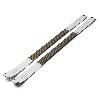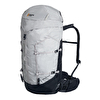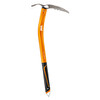Cima Scotoni Dolomites Direttissima climbed by Nicola Tondini

 1 / 20
1 / 20 Enrico Veronese
Enrico Veronese
One might say that some climbs represent those who dreamt about and first ascended them. In short, they speak volumes about the first ascentionist and how he or she interprets a particular climb. This certainly holds true for the huge Direttissima put up by Nicola Tondini - with Ingo Irsara, Andrea Simonini, Nicola Sartori and Luca Montanari - on the great and famous SW Face of Cima Scotoni in the Italian Dolomites. Quoting a phrase of Armando Aste, Tondini states that alpinists are "those who search for the infinite. Those who want to go beyond, ever further." Tondini’s "beyond" initially led him from the rock faces in the Brentino valley to the first ascent of Quo vadis on Sass of Crusc and the first ascent of Colonne d’Ercole on the NW Face of Civetta. And now to this Direttissima up the overhanging Cima Scotoni. The route, as Tondini explains, was "exclusively free climbed (without any use of aid). Pegs were placed using hooks. No additional rests were made on hooks between one piece on gear and the next, nor were any moves made with the use of aid." Put in other words, wherever he stopped (and clipped into hooks), repeat ascentionists will find a peg. This isn’t always the case, as in the past some routes have been first ascended with the use of aid (traditional) and then freed at a later stage, with some "excessive" in-situ pegs even removed. On this Direttissima it is as if Tondini, at every peg, denounced his free climbing ability. In short, this is a style of first ascending a route that pushes free climbing to the max, similar to what has been done for decades by Rolando Larcher and C. It is worth mentioning that the pitches are protected only by normal pegs (89 in 733 meters split into 24 pitches). While bolts (15) was only used to reinforce some belays (8 in total). The route breaches maximum difficulties of grade X (8b) and obligatory IX- (7b +). Tondini forged all pitches and completed the route on 3 August 2014, requiring 10 days split over 4 years. 5 days were needed to free the pitches: 26/09/2016 (with Luca Gelmetti); 27/10/2016 (with Federico Carollo); 23/05/2017 (with Lorenzo D'Addario) as well as two further days of failed attempts (with Alessandro Baù and Luca Gelemetti). All that remains to be added is that route deals with the steepest section of Cima Scotoni; starting to the left of Zauberlerling (Christoph Hainz, Oswald Celva) it runs parallel to Zauberlerling and the route put up by Hannes Pfeifhofer and Simon Gietl in 2009, while on the upper section in ascends to the right of the latter. It’s also worth noting that pitch 3 of the Direttissima crosses the belay of Zauberlerling, and "crosses" the Pfeifhofer - Gietl route on the first ledge. A word about the route name: "Non abbiate paura… di sognare", which translates as Don’t be afraid ... to dream. It's a manifesto for how much climbing, even today, is still a search for something special and an adventure. As Tondini explains in his report.
NON ABBIATE PAURA DI SOGNARE Don’t be afraid ... to dream by Nicola Tondini
3 August, 2014. I'm at the belay with Andrea Simonini below the last pitch. We can see the summit 50 meters away. It's my tenth day on this project and the fifth with Andreino. I'm really, really keen on finishing things off, finally completing my project. I’d spent the first three days on this climb with Ingo Irsara, back in 2011, the same year I redpointed my route on Sass dla Crusc. At the time, during a couple of days of uncertain weather we made our way to Cima Scotoni and climbed the first 3 pitches. Then in 2012 another day resulted in pitches 4 and 5. Later that year I teamed up with Andrea and we reached the first ledge. 2013 was dedicated to dealing with the central section and breaching the huge overhang that features so prominently in the central section of the face. I spent 3 long days on the route that year: the first with Andrea and Ingo; the second - through the overhang - with Andrea and the third with Nicola Sartori. 2014 started with me on Scotoni once again, this time with Luca Montanari, establishing the 3 pitches that lead to the second ledge. And so here we are now, on 3 August: Andrea joins me up the last section that leads to the summit. I'm happy that I’m tied in with him again, that I’m finally going to finish the route. I want to put myself to the test all the way to the very end. I’d scrutinised and examined this face a thousand times. I know it might be risky heading straight towards the huge bulge in the middle of the last two overhangs, but I just can’t resist it. I say to Andrea: "Just let me go and have a quick look... just to hammer in a peg… just to try the moves…" and then all of a sudden I climb past the final overhang and reach the top…
23 May, 2017. Today, Thursday 25 May, I'm finally realizing what happened two days ago. I finally managed to redpoint the most difficult route I’ve ever first ascended. Even if the single push repeat still awaits, I feel lighter than ever before. The Direttissima up Cima Scotoni represents a goal, a dream of a lifetime's climbing. It may mean little when compared to what else goes on in the vertical world (a glance at Dawn Wall suffices to remain annihilated), but in the small world of the Dolomites, this climb has its say. The idea was to climb it using the modern style I’ve always adopted, that refutes the use of aid and allows for hooks only in order to place pegs, not to rest between one piece of pro and the next (where I used hooks on this route repeat ascentionists will always find a good peg). The line I chose is like something from the past: a line straight up into the sky. That’s because the climb tackles a corridor, that space left untouched between the other routes, directly up through the wall's steepest bulges. I dreamt about doing this without placing any bolts along the pitches and the Scotoni rock provided us with this unique gift; all pitches are protected by traditional means only. And only 9 of the 24 belays have bolts on them.
Could I have done better? Definitely. Had I not had a drill with me, had I managed to establish the route in a single push without ever abseiling back down to the ground, yes, that would have pushed this adventure to the max. But for me this is already more than enough: first ascending a route in this style, up to 8a/b, meant I spent my best climbing days of the last few years up on this face. Whenever I was on top form, I was up on the route.
Direttissima Scotoni – "non abbiate paura… di sognare". Don’t be afraid... to dream. I often had to repeat this to myself : don’t be afraid of dreaming about completing this route! I dreamt of experiencing a great adventure while putting up this climb. I dreamt of adopting a style that opened the doors to adventure, to not knowing beforehand whether I’d manage to free climb all the sections that lay in store. I repeated this mantra every minute of day 2, while I continued to fall onto the last two pegs of pitch 3 as I failed to unlock the right sequence that led to the ledge 6-7 meters higher and the logical belay. I kept repeating these words as I fought for 6 hours to get to grips with pitch 15, as I searched for the free line through those huge overhangs. I kept repeating the phrase when, faced by a compact yellow section on the next pitch, I asked myself where on earth I might be able to stop and hammer in a peg… but then the rock gave me with a present: one of the most beautiful, biggest and unexpected threads I’ve ever seen on a pitch as difficult as this one.
I was afraid at the start of 2014 when I hurt my shoulder skiing and subsequently realised that after spending two days on the last pitches I was forced to take several rest days in order for the pain to go away (in October Alessandro Baù and I had made a tentative redpoint attempt up the first pitches, to no avail). I was scared when two summers went by (all of 2015 and 2016 until September) without me even touching the line: what was the point of even trying a route like this, if I wasn’t able to free the third pitch (I can only send 8b when I’m on top form)?And I got anxious when I didn’t know who might be interested in joining me on such a demanding redpoint project.
Having said that, 2016 started out well. I’d concentrated on two big projects in Val d'Adige and finally managed to climb harder than 8b. So the desire and courage to put myself to the test returned and I grabbed the opportunity of being accompanied by Luca Gelmetti for a two-day redpoint attempt. On the first day (September 26) we set off at around 10.00am in order to try the crux pitch (pitch 3, circa 8b) in the sun. The redpoint required 3 attempts. We then continued until the first ledge and ended the day guided by the light of our headlamps. The subsequent pitches (from 4 to 11) are easier, but as the difficulties ease off, the pro becomes increasingly demanding.
So between 7a and 7b+ you have to climb with runout gear that often needs to be backed up completely with friends. All you risk is long falls, seeing that the face overhangs constantly, but it’s always psychologically demanding. That day we tried to continue upwards and so I checked out the moves on pitch 15 - an 8a circa - but was then too tired to free it. I returned on 27 October with Federico Carollo. We enjoyed a spectacular day in superlative weather and autumn colors. By now though the days had become too short to free the difficult pitches between the first and second ledge, so I redpointed the last 5 which are crowned by a beautiful final 8a.
2017: at the first spell of good weather that coincided with me being on form I teamed up with Lorenzo D'Addario who was thrilled to spend a long day in the middle of the Cima Scotoni overhangs. So at 10.00 am on 23 May we started up the first pitch above the first ledge. Enrico Veronese also accompanied us and, using a fixed rope placed between the 15th and 16th pitch, took some photos and filmed some of the action. On both these pitches I needed two attempts to make the redpoint. At 19.00 we were 3 pitches short of the second ledge, luckily though everything ran smoothly and shortly after 21.00 all three of us were safely at Cima Scotoni’s second ledge.
Now there’s a really superb climb on Cima Scotoni that starts at the peak's lowest point and ascends directly up to the top, past the overhangs through the three distinct sections of the face. It was first ascended without the use of aid and without any bolts on the actual pitches (bolts were only used to make 9 of the 24 belays safe) and with difficulties up to 8b. Hooks were used to place pegs and not to rest between one section of the climb and the next. This Cima Scotoni Direttissima is perhaps one of the few routes in the Dolomites harder than 8a first ascended in this style.
Here is, in short, the route in numbers: 3 pitches between 7c+/8a and 8b, 4 pitches 7b/7b+ with runout gear and pro that needs integrating, 5 pitches between 7a/7a+ often completely needing pro and another 12 pitches between grade V and 6c. In total: 24 pitches with 15 peg belays and 9 bolt belays.
- Download the route topo
Thanks
Thanks to all my climbing partners who accompanied me on this adventure: Ingo Irsara and Andrea Simonini and my XMountain mountain guide colleagues: Nicola Sartori, Luca Montanari, Alessandro Baù, Luca Gelmetti and Lorenzo d'Addario.
Thanks to my sponsors: Marmot, Ferrino, Wild Climb, Edelrid, Dolomite
by Nicola Tondini, XMountain mountain guide



 Copia link
Copia link



















 See all photos
See all photos
























